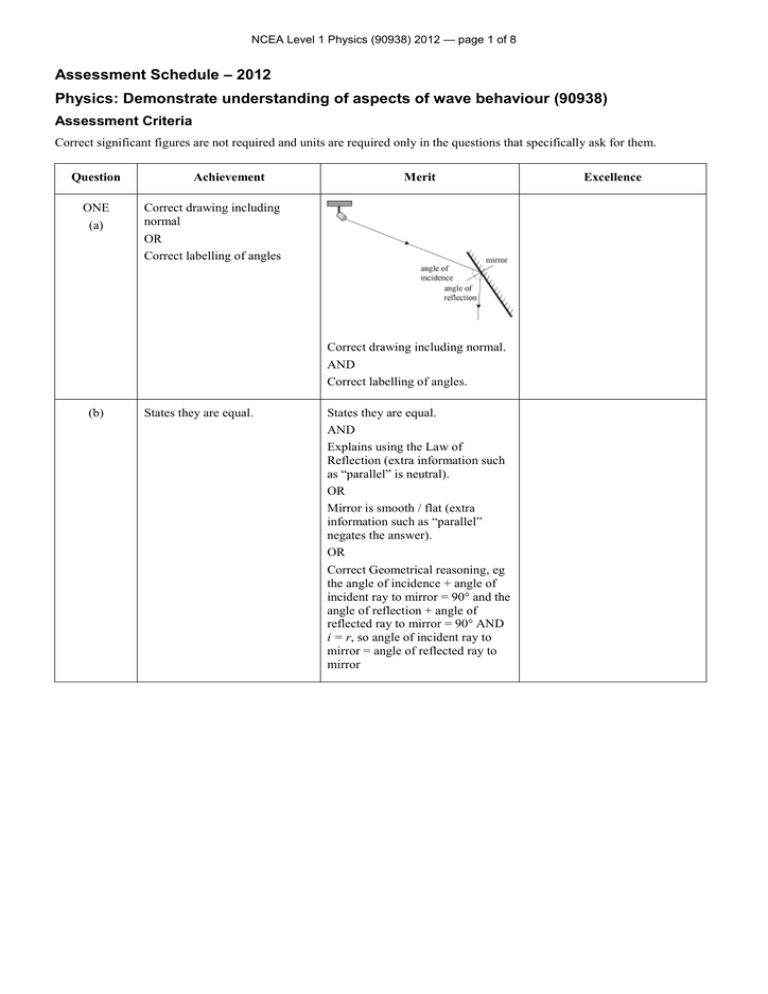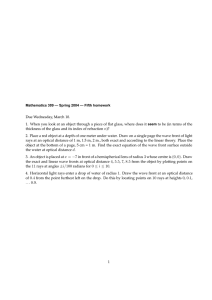(626KB)
advertisement

NCEA Level 1 Physics (90938) 2012 — page 1 of 8 Assessment Schedule – 2012 Physics: Demonstrate understanding of aspects of wave behaviour (90938) Assessment Criteria Correct significant figures are not required and units are required only in the questions that specifically ask for them. Question ONE (a) Achievement Merit Correct drawing including normal OR Correct labelling of angles Correct drawing including normal. AND Correct labelling of angles. (b) States they are equal. States they are equal. AND Explains using the Law of Reflection (extra information such as “parallel” is neutral). OR Mirror is smooth / flat (extra information such as “parallel” negates the answer). OR Correct Geometrical reasoning, eg the angle of incidence + angle of incident ray to mirror = 90° and the angle of reflection + angle of reflected ray to mirror = 90° AND i = r, so angle of incident ray to mirror = angle of reflected ray to mirror Excellence NCEA Level 1 Physics (90938) 2012 — page 2 of 8 (c)(i) and (ii) (d)(i) (i) X is drawn correctly OR (ii) ONE ray is drawn correctly including dotted line for virtual ray and arrows and X as point of origin for virtual ray. (Allow virtual rays from top / bottom of girl’s image as opposed to X.) (i) X is drawn correctly AND (ii) ONE ray is drawn correctly including dotted line for virtual ray and arrows and X as point of origin for virtual ray. (Allow virtual rays from top / bottom of girl’s image as opposed to X.) EITHER of the incident rays are drawn correctly including arrows. EITHER of the rays are fully drawn correctly, including arrows and dotted lines. (i) X is drawn correctly AND (ii) BOTH rays are drawn correctly including dotted lines for virtual rays and arrows and X as point of origin for virtual ray. (Allow virtual rays from top and bottom of girl’s image as opposed to X.) BOTH of the rays are fully drawn correctly including arrows and dotted lines ((ii) The explanation that: The top of the mirror needs to be just above eye level to be able to see her head. OR The light from her feet is reflected off the mirror at the midpoint between the floor and the eye level to be able to see her feet is supported by the ray diagram (although this may not be complete). The explanation that: The top of the mirror needs to be just above eye level to be able to see her head. AND The light from her feet is reflected off the mirror at the midpoint between the floor and the eye level to be able to see her feet is supported by the ray diagram (although this may not be complete). NØ N1 N2 A3 A4 M5 M6 E7 E8 No evidence 1a 2a 3a 4a 2m 3m 2e 3e NCEA Level 1 Physics (90938) 2012 — page 3 of 8 Question Achievement Merit TWO (a)(i) (ii) Transverse / electromagnetic wave (or suitable alternative) AND Longitudinal/sound (or suitable alternative) wave. (b) Space communications use electromagnetic waves / transverse waves / Wave A. OR Space communications do not use sound / longitudinal waves / Wave B. Space communications use electromagnetic waves / transverse waves / Wave A. They do not require a medium to travel. OR Space communications do not use sound / longitudinal waves / Wave B. They require a medium to travel (and space has no medium / space is empty). (c) Frequency affects pitch OR The pitch decreases (but “frequency decreases means increase in pitch” is incorrect) AND Amplitude affects loudness OR Loudness increases (but “increased amplitude means decreased loudness” is incorrect) Clearly links (cannot be inferred): Frequency to pitch AND states the pitch decreases (by exactly what proportion is not marked) because it depends on the frequency. OR Clearly links (cannot be inferred): Amplitude to loudness AND states that loudness increases (by exactly what proportion is not marked) because loudness depends on amplitude. (d)(i) Excellence Clearly links (cannot be inferred): Frequency to pitch AND states the pitch decreases (by exactly what proportion is not marked) because it depends on the frequency. AND Clearly links (cannot be inferred): Amplitude to loudness AND states that loudness increases (by exactly what proportion is not marked) because loudness depends on amplitude. A pulse is a single disturbance / crest / trough that moves through a medium from one point to the next point. OR A pulse transfers a small amount of energy from one point to the next point in the medium. NCEA Level 1 Physics (90938) 2012 — page 4 of 8 (ii) Calculates the speed of the wave in the cable as Calculates the speed of the wave in the cable as = 0.60 3.0 108 Calculates the speed of the wave in the cable as = 0.60 3.0 108 = 1.8 108 m s–1 OR = 1.8 10 m s AND = 1.8 108 m s–1 AND d incorrectly to t calculate the up and down distance travelled by the pulse Eg: using incorrect value for v as 3 108, to completion (eg 690 m) using incorrect value for v as 1.8 10–8, to completion using incorrect value for t as 2.3 10+6 to completion. Uses v = 8 Uses v = –1 d correctly using t 1.8 108 to calculate the up and down distance travelled by the pulse to completion but gets incorrect answer (eg 414 m). = 0.60 3.0 108 Uses v = d correctly using t 1.8 108 to calculate the up and down distance travelled by the pulse to completion = 2.3 10–6 1.8 108 = 414 m AND Realises that the echo is the up and down distance so divides by 2, ie The fault is 414 = 207 m away. 2 NØ N1 N2 A3 A4 M5 M6 E7 E8 No evidence 1a 2a 3a 4a 2m 3m 2e 3e NCEA Level 1 Physics (90938) 2012 — page 5 of 8 Question THREE (a)(i) Achievement Merit Excellence Diffraction is the bending of waves round an obstacle / through a (small) gap. Diffraction is the bending of waves round an obstacle / through a small gap. AND Yes Diffraction is the bending of waves round an obstacle / through a small gap. AND (Yes) Longer wavelength diffract more than shorter ones (but if talking about diffraction through a gap then the gap must approximately equal the wavelength). The sketch shows the correct shape (straight wave fronts for part of wave moving straight on without being diffracted AND curved wave fronts behind the peninsula), but the wave length changes. OR The sketch shows the wavelength staying the same but with wrong shape. The sketch shows the correct shape (straight wave fronts for part of wave moving straight on without being diffracted AND curved wave fronts behind the peninsula) with no change in wavelength, but the diffraction does not occur in line with the edge of the peninsula. Calculates the frequency correctly. Frequency, f = 0.67 Hz But incorrect calculation of v from f. OR Incorrectly calculates value of f, but calculates v correctly from incorrect value of f. Calculates the frequency correctly. Frequency, f = 0.67 Hz AND correctly calculates v (ii) (b) (c) v = f λ = 0.67 0.85 = 0.57 m s–1 (unit not required) The sketch shows the correct shape (straight wave fronts for part of wave moving straight on without being diffracted AND curved wave fronts behind the peninsula) with no change in wavelength. AND The diffraction occurs in line with the edge of the peninsula. v = f λ = 0.67 0.85 = 0.57 m s–1 (unit not required) NCEA Level 1 Physics (90938) 2012 — page 6 of 8 (d)(i) (Time) Period OR Calculates the wavelength correctly. (Time) Period AND Calculates the wavelength and frequency correctly. 1.2 = 0.40 m 3 (Be careful because 0.64 / 1.2 = 0.53. which is entirely wrong.) Wavelength = Wavelength = f = v l = 1.2 = 0.40 m 3 0.64 = 1.6 Hz 0.4 (Time) Period AND Calculates the wavelength and frequency correctly. Wavelength = f = v l = 1.2 = 0.40 m 3 0.64 = 1.6 Hz AND 0.4 OR Calculates the wavelength and frequency correctly. Wavelength = f = v l = 1.2 = 0.40 m 3 Calculates the Time Period correctly. T= 1 1 = = 0.63 f 1.6 = 0.63 s 0.64 = 1.6 Hz 0.4 AND Calculates the Time Period correctly. T= 1 1 = = 0.63 f 1.6 = 0.63 s NØ N1 N2 A3 A4 M5 M6 E7 E8 No evidence 1a 2a 3a 4a 2m 3m 2e 3e NCEA Level 1 Physics (90938) 2012 — page 7 of 8 Question Achievement Merit FOUR (a) Light slows down entering the plastic. OR Light speeds up as it leaves the plastic. Light slows down entering the plastic. AND Light speeds up as it leaves the plastic. (b)(i) The optical density of medium A is greater than that of medium B. OR The angle of incidence is equal to the critical angle The optical density of medium A is greater than that of medium B. AND The angle of incidence is equal to the critical angle. Correct Total Internal Reflection at B. OR Correct bending of rays at A and C. Correct Total Internal Reflection at B including correct drawing of normal AND Correct bending of rays at A and C including correct drawing of normal. (ii) (c) Excellence Correct Total Internal Reflection at B including correct drawing of normal. AND Correct bending of rays at A and C including correct drawing of normal. AND Incident ray to prism and emergent ray are parallel to each other. NCEA Level 1 Physics (90938) 2012 — page 8 of 8 (d)(i) ONE of the rays is drawn correctly (arrows not required). Correct ray diagram including clear identification of two rays of light by one / two arrows (or different pen colour). Correct ray diagram including one / two arrows (or different pen colour). (ii) AND Upright, because the relative positions of the rays remain the same before and after the reflection / laterally inverted twice. (iii) The rays enter and leave the prisms at right angles / perpendicular to the faces of the prism. The rays enter and leave the prisms at right angles / perpendicular to the faces of the prism. AND No refraction / bending of rays takes place. The rays enter and leave the prisms at right a angles / perpendicular to the faces of the prism. AND No refraction / bending of rays takes place. AND It is the refraction / bending of light that causes dispersion of different colours. NØ N1 N2 A3 A4 M5 M6 E7 E8 No evidence 1a 2a 3a 4a 2m 3m 2e 3e Judgement Statement Score range Not Achieved Achievement Achievement with Merit Achievement with Excellence 0–9 10 – 18 19 – 25 26 – 32


